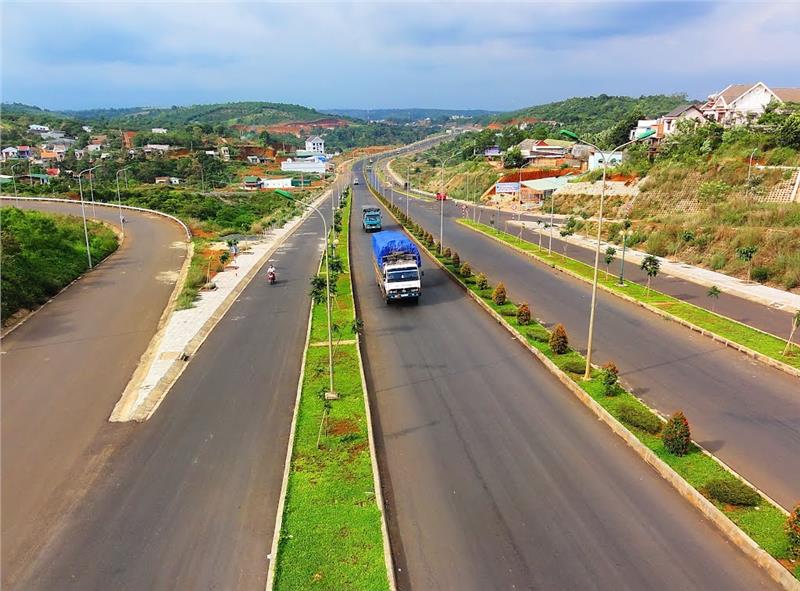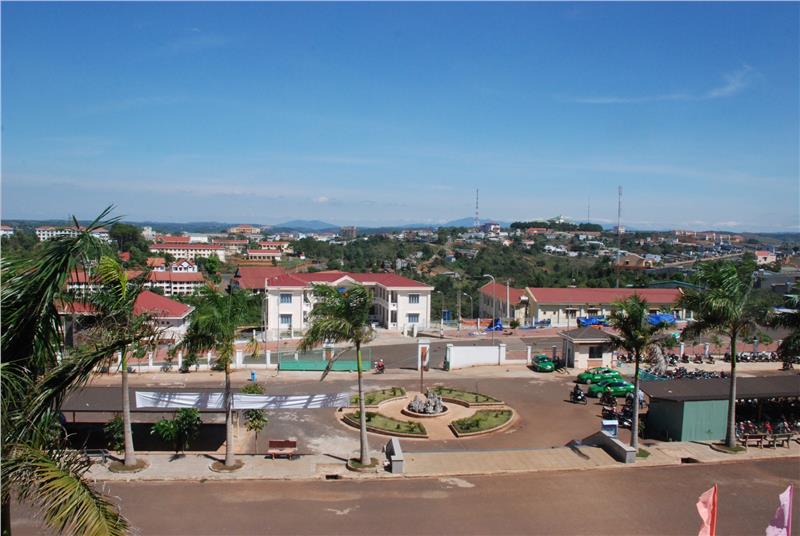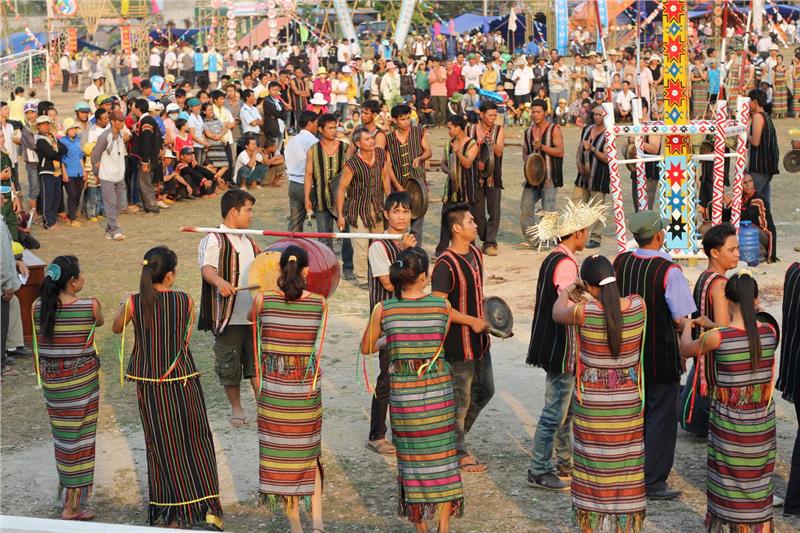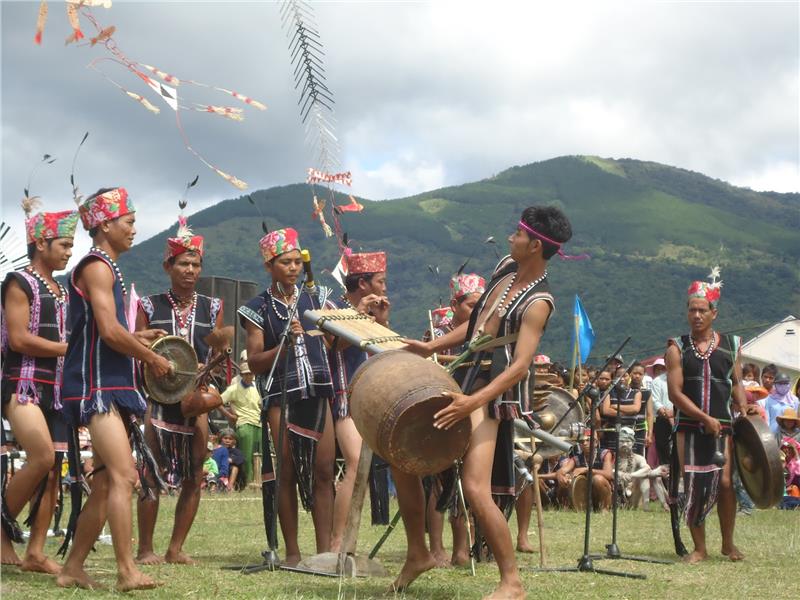Dak Nong or Dac Nong is a province in Central Highlands Vietnam. Dak Nong Province was re-established on January 1st, 2004 under the Resolution No.23/ 2003/ QH11 issued on November 26th, 2003 by the National Assembly on the basic of separating Dak Lak province into Dak Nong province and Dak Lak province.

Dak Nong is located at the gateway to the southwest of Central Highlands. Its geographical coordinates are 11°45 - 12°50 north latitude and 107°12 - 108°07 east longitude. The center of Dak Nong is located 125km from Buon Ma Thuot City along Highway 14, and 250km south of Ho Chi Minh City. The province is adjacent to Dak Lak in the north and northeast, Lam Dong in the east and southeast, Binh Phuoc in the south and Cambodia in the west with 120km long border through 2 border gates of Dak Per in Dak Mil province and Bup'rang in Tuy Duc district. Dak Nong situates on M'Nông plateau, with an average elevation of 600 meters to 700 meters above sea level, the highest point is in Ta Dung with up to 1,982 meters altitude. Dak Nong topography is lower and stretches from east to west. Its terrain is diverse and heavily dissected, with high mountains, the vast plateau and low-lying plain.
Dak Nong climate is the transition between the two sub-climates of Central Highlands and Southeast Vietnam, so the climate features the common characteristics of equatorial tropical monsoon climate. The climate is divided into 2 distinct seasons: dry season and rainy season. The rainy season often lasts from April to November, focusing over 90% of the rainfall in year. The average rainfall is 2513mm. The dry season starts from December to March of next year. The annual average temperature is 22-23°C, the highest temperature is 35°C and the lowest temperature is 14°C. Dak Nong has a network of rivers, lakes, dams distributed relatively evenly, facilitating to exploit water sources for agricultural and industrial production, hydroelectric projects. Dak Nong land is plentiful and varied; the land is divided into 5 main groups including red soil, basaltic soil and black soil.
Under French occupation of Vietnam in 1893, the French ruled the whole Central Highlands, including Dak Nong province. Their administrative system focused on Dak Mil and Dak Song. In 1940, besides Buon Ma Thuot prison, the French colonists erected Dak Mil Jail (now in Dak Mil district, Dak Nong). January 1959, Republic of Vietnam cut the western part of Dak Lak province, part of Kien Hoa district of Thu Dau 1 to establish Quang Duc province. Administrative boundary of Quang Duc province was basically like Dak Nong provincial boundaries today, divided into 3 districts: Duc Lap, Kien Duc, Khiem Duc and administrative area of Duc Xuyen. In early 1962, the revolutionary government decided to dissolve Quang Duc province, merge Duc Lap, Duc Xuyen into Dak Lak Province, Kien Duc into Phuoc Long province and Khiem Duc into Lam Dong province. May 1975, Quang Duc province was re-established. November 1975, Quang Duc province was merged into Dak Lak Province. On January 1st, 2004, Dak Nong province was re-established under Resolution No. 23/ 2003/ QH11 issued by National Assembly on the basic of separating Dak Lak province.

The administrative units of Dak Nong Province consist of Gia Nghia Town, Cu Jut District, Dak Glong District, Dak Mil District, Dak R'lap District, Dak Song District, Krong No District and Tuy Duc District. Among them, there are 72 communal administrative units including 61 communes, 5 wards and 5 towns.
Dak Nong population is 516,300 people, the population density reach 79 people/ km². Urban population reach nearly 78,300 people and rural population are 438,000 people. Natural population growth rate increases by 14.4 ‰. Dak Nong has 40 ethnic groups living together. Among them, Kinh ethnic people cover the majority of Dak Nong population with 332,431 people. The second group is M'nong people with 39,964 people and the third position is Nung people with 27,333 people. Mong ethnic people rank the fourth with 21,952 people along with other ethnic groups as Tay, Dao, Thau, Ma, Ede, Hoa, Muong, etc.

Dak Nong economy grows steadily, economic restructuring goes in the right direction; the economic indicators are positive signals. GDP per capita in 2014 was estimated at 32.75 million dong, exceeding the plan. Agricultural production is stable, production methods had the development, and the rural areas are gradually changing. Total turnover of retail goods and service revenues increased over the same period. Exports and imports rose sharply over the same period. Consumer price index (CPI) stabilized the whole year, tourism activities and transport grew sharply. The total state budget revenue in the province was estimated at 1354 billion dong, approximately the estimate. Attract investment, promote advocacy and disbursement of ODA, review licensed projects, and grasp the situation of the project, timely support investors.
The quality of education continues to be improved, the scale is expanded, and facilities gradually better meet the needs of teaching and learning. Creating jobs achieved the plan, scaling the effective vocational training models, building models of vocational training linked to the villages, intensive farming areas; the percentage of trained workers increased yoy. Health network are maintained regularly and gradually improve the quality of service, disease prevention is actively deployed, and the disease is completely controlled. It is focusing on advocacy, organizing cultural activities to celebrate the major holidays, conserving, promoting and developing national culture. External activities have positive changes. The province has actively expanded the cooperation, association and investment with a number of provinces and cities in the country, with a number of international financial institutions, non-governmental organizations and embassies, consulates countries.

Excellent cultural features of Dak Nong perhaps are still part of Dak Lak province because this is a region of Dak Lak for a long time. However, ethnic groups in the province have created a vibrant traditional culture with their own identities. It retains many unique oral epics as Dam San epic. The ancient customary laws, architectural stilt house, communal house, and images in graves contain many fascinating mysteries. Ethnic musical instruments have long been famous and are the pride of the Central Highlands in particular and the folklore of Vietnam in general. There is Dan da (Lithophone) of M'Nong ethnic people, Chieng da (stone gong) in Dack R'lap dating bacting thousand years ago, T'rung, K'long put, trumpet, flute and so on. In addition, the special culture of Dak Nong is reflected through unique festivals. During the festival, the villagers hold hands and dance around the fire with the sound of the gong.

Dak Nong tourism is constantly diversifying tourism products, to satisfy the needs of visitors. Services are increasingly invested, upgraded and gradually asserted their brand, from accommodation services, transportation services, travel services, services to sightseeing and shopping. Phap Hoa Pagoda is located in the center of Gia Nghia town, with the area of about 800 square meters built in 1957. The architecture of the pagoda is inspired by the architecture in stilt houses of Central Highland, mixed with garden architecture to form the tranquil space and the convergence of the Buddhist people. When standing on the campus, visitors can admire the beautiful and majestic scenery, with undulating mountains, rolling green trees ... Inside the temple, there is a spacious space with the statue of Bodhisattva Avalokitesvara. Also, the pagoda's campus was also decorated many ornamentals and many different kinds of flowers, in the harmonious arrangement to give people the calm and quiet sense.
Ea Sno Lake is a natural lake with charming scenery located in Dak Ro commune, Krong No district. Looked from above, the lake surface looks like a sparkling giant silver mirror. Around the lake is special-use forests with many trees and rare animals such as snakes, turtles, monkeys, deers, python...Thanks to the wide lake area, Ea Sno lake has a rich and diverse ecosystem. When visiting Ea Sno Lake, visitors will have the opportunity to boat on the lake and admire the pristine beauty of the mountains and enjoy the cool breezes, the worries and chaos of life will be dispelled. The system of 3 waterfalls including Dray Sap, Gia Long and Trinh Nu are indispensable attractions in Dak Nong. Dray Sap is seen as the most beautiful and majestic waterfalls in Central Highlands. According to Ede language, it means smoke. Located in the center of Ea T'ling town, Cu Jut district, Trinh Nu waterfall is not majestic as Gia Long or Dray Sap, but it is poetic, gentle nestles under the reef. The attraction of the falls is not only by the legendary story but also the beauty of rocks, forests, waterfalls and fresh air.
A part of the Nam Nung Natural Reserve, Nam Nung ecological-cultural-historical tourist area stretches in 5 communes including Nam Nung, Nam N'Dia, Duc Xuyen (Krong No), Quang Son (Dak Glong) and Nam N'Jang (Dak Song). With an area of about 12,300 hectares, this area has great potential in terms of both natural resources and human values. Thanks to unspoiled quiet and poetic scenery, it has become an ideal stopover of tourists who love natural beauty. This is also an ideal tourist attraction with unique architectural works, converging cultural beauty of the land and people in Central Highlands. Climb to Nam Nung peaks, visitors can admire the panoramic view of majestic M'Nong plateau. Nam Nung peak will be ideal place for those who enjoy exploring and adventure.
Festival

The province has 40 ethnic groups living together; each ethnic group has its own unique culture and traditional festivals, reflecting the cultural and spiritual life, and human conception. Therefore, festival in Dak Nong is one of the special cultural forms appealing visitors. Traditional festivals of ethnic groups as M'Nong, Ede, Ma, etc handed down until today are rituals which are associated with important milestones in the cycle life of human and everything. Typical festivals are festival to pray for rain, new rice feast, celebrating new home, wedding, bo ma ritual... The unique festival is held in different scale, but bears the traditional culture.
